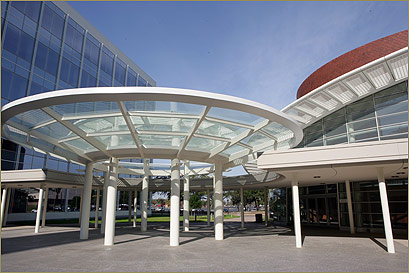
Not too long ago deconstructing and analyzing DNA codes took scientists several years and enough computer hardware to fill the entire floor of a building.
Now a genetic sequencer the size of a washing machine can do the work in a couple of days, and University of Houston researchers will be among the first in the region to use this cutting-edge device.
The sequencer is just one of the state-of-the-art research tools slated for the Science and Engineering Research and Classroom Complex (SERCC). Over the past year, more than $3 million in federal and private grants has been earmarked to begin equipping the building’s labs.
The sequencer was purchased with a $750,000 grant from the Cullen Foundation to UH’s Institute for Molecular Design, which Pettitt heads. Another $500,000 from the M.D. Anderson Foundation to the institute will help equip labs in SERCC.
The raising of funds to outfit the building continues, and once it is finished, UH will boast truly world-class science facilities, said Montgomery Pettitt, associate dean of research for the College of Natural Sciences and Mathematics.
“Putting biology and chemistry and engineering together to do research is potentially very exciting,” Pettitt said. “Many of the best opportunities for high-impact work in science and engineering happen between traditional disciplinary boundaries. In a facility like this, our students can learn to work in ways that will transform our understanding, not just extend it.”
Set to arrive by December, the $500,000 sequencer will help make UH a major player in genetic science, Pettitt said. The sequencer will be only the second of its kind in Houston – the Baylor College of Medicine just recently acquired this technology as well.
An organism’s genome can contain the equivalent of millions of pages of data, Pettitt said. Breaking up the astonishingly complex genome into smaller chunks for study and then piecing it back together is an arduous task, but the high-powered sequencer can perform large, rapid scans of genetic material.
Whether it’s zeroing in on the slightest hint of virus or bacteria from a mouth swab or constructing an ecological profile of an area by studying remnant DNA molecules that could be millions of years old, the sequencer will help researchers in a number of groundbreaking endeavors.
It will even help scientists engaged in synthetic biology – the creation of new bacterial life forms with synthesized genes designed to perform specific functions. Although life forms from scratch are still a ways off, the sequencer opens up new possibilities in genetic analysis, Pettitt said.
Federal grants will pay for a nuclear magnetic resonance device and hoods and benches for synthetic chemistry facilities.
About $1 million in federal money was designated for the air-handling system in the SERCC clean room. The clean room will give scientists the completely sanitary environment necessary to work on bio-nanotechnology.
Researchers must wear sterile and dust-free gowns while inside and an expensive air system is needed to filter out even the tiniest dust particles, Pettitt said. The filtering system to be purchased for SERCC’s clean room will screen out any dust particle larger than 10 microns, or anything thicker than 100th the width of a human hair. |

